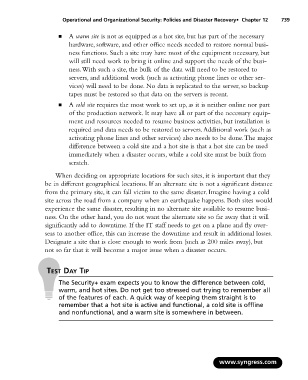Page 755 - StudyBook.pdf
P. 755
Operational and Organizational Security: Policies and Disaster Recovery• Chapter 12 739
■ A warm site is not as equipped as a hot site, but has part of the necessary
hardware, software, and other office needs needed to restore normal busi-
ness functions. Such a site may have most of the equipment necessary, but
will still need work to bring it online and support the needs of the busi-
ness.With such a site, the bulk of the data will need to be restored to
servers, and additional work (such as activating phone lines or other ser-
vices) will need to be done. No data is replicated to the server, so backup
tapes must be restored so that data on the servers is recent.
■ A cold site requires the most work to set up, as it is neither online nor part
of the production network. It may have all or part of the necessary equip-
ment and resources needed to resume business activities, but installation is
required and data needs to be restored to servers.Additional work (such as
activating phone lines and other services) also needs to be done.The major
difference between a cold site and a hot site is that a hot site can be used
immediately when a disaster occurs, while a cold site must be built from
scratch.
When deciding on appropriate locations for such sites, it is important that they
be in different geographical locations. If an alternate site is not a significant distance
from the primary site, it can fall victim to the same disaster. Imagine having a cold
site across the road from a company when an earthquake happens. Both sites would
experience the same disaster, resulting in no alternate site available to resume busi-
ness. On the other hand, you do not want the alternate site so far away that it will
significantly add to downtime. If the IT staff needs to get on a plane and fly over-
seas to another office, this can increase the downtime and result in additional losses.
Designate a site that is close enough to work from (such as 200 miles away), but
not so far that it will become a major issue when a disaster occurs.
TEST DAY TIP
The Security+ exam expects you to know the difference between cold,
warm, and hot sites. Do not get too stressed out trying to remember all
of the features of each. A quick way of keeping them straight is to
remember that a hot site is active and functional, a cold site is offline
and nonfunctional, and a warm site is somewhere in between.
www.syngress.com

